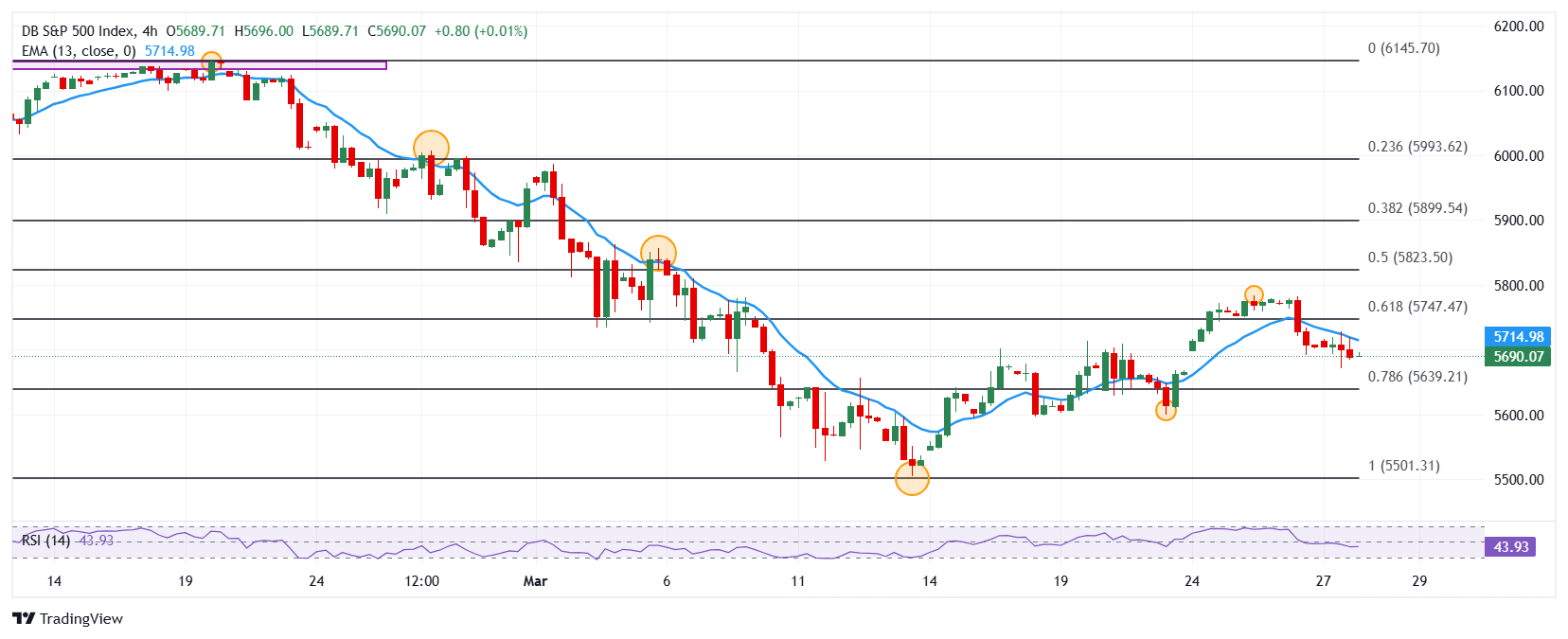- The S&P 500 share index has a loss of 0.25% today, contributing currently in 5690.
- The shares of General Motors (GM) collapse 7.36% daily, reaching minimums provided since March 11.
- Super Micro Computer’s titles lose 6.26% on Thursday, reaching minimal not seen since February 7.
- The president of Boston’s Fed, Susan Collins, acknowledged that it is inevitable that tariffs increase inflation in the short term.
- The financial markets are cautious before the tariff climbing to the automotive industry imposed by Donald Trump.
The S&P 500 marked a maximum of the day in 5,728, finding aggressive vendors that dragged the index to lower minimums of March 24 in 5,671. Currently, the S&P 500 operates around 5,690, falling a zero 25% in the day.
Donald Trump’s commercial rhetoric drags the main stock loss zone to the main stock market
The S&P 500 maintains the bassist perspective today, falling 0.25% and ending the American session in 5,690, signing its second whose consecutive day with losses after the 25% tariff imposition to imported cars in the United States.
In this context, the shares of General Motors (GM) collapse 7.36% daily reaching minimums not seen since March 11 in 46.26 $. On the other hand, the values of Super Micro Computer (SMCI) lose 6.26% in the day, reaching minimum of February 7 in 34.66 $, signing its third consecutive day down.
On the other hand, the president of the Boston Federal Reserve, Susan Collins, said that it is inevitable that tariffs increase short -term inflation, so she consolidates her position of maintaining rates without changes.
Levels to be considered in the S&P 500
The S&P 500 reacted down from a short -term resistance given by the maximum of February 25 in 5,784. The next key resistance is observed by 5,857 maximum of March 5. Down, we observe the key support in 5,504, pivot point of March 13.
4 -hour graph of the S&P 500

NASDAQ FAQS
The Nasdaq is an American stock exchange that began being an electronic value quoter. At first, the Nasdaq only offered quotes of extraburstile values (OTC), but later also became a bag. In 1991, Nasdaq had grown up to 46% of the entire US stock market. In 1998, it became the first US stock exchange to offer online negotiation. The Nasdaq also prepares several indexes, the most complete of which is the Nasdaq Composite, which represents the more than 2,500 Nasdaq values, and the Nasdaq 100.
The Nasdaq 100 is a large capitalization index composed of 100 non -financial companies of the Nasdaq stock exchange. Although it only includes a fraction of the thousands of Nasdaq values, it explains more than 90% of the movement. The influence of each company in the index is weighted based on stock capitalization. The Nasdaq 100 includes companies that are very focused on technology, although it also encompasses companies from other sectors and outside the United States. The annual average profitability of Nasdaq 100 has been 17.23% since 1986.
There are several ways to operate with the Nasdaq 100. Most of the Stred Betting Retail Corridors and Platforms offer bets through contracts by difference (CFD). For long -term investors, quoted funds (ETF) operate as shares that mimic the movement of the index without the investor having to buy the 100 companies that compose it. An example of ETF is the investment QQQ Trust (QQQ). Nasdaq 100 futures contracts allow specular to the future evolution of the index. The options provide the right, but not the obligation, to buy or sell the NASDAQ 100 at a specific price (exercise price) in the future.
There are many factors that promote Nasdaq 100, but mainly it is the aggregate performance of the companies that compose it, revealed in their reports of quarterly and annual results. American and world macroeconomic data also contribute, since they influence investors’ confidence, which is positive drives profits. The level of interest rates, set by the Federal Reserve (FED), also influences Nasdaq 100, since it affects the cost of credit, which many companies depend largely. Therefore, the level of inflation can also be an important factor, as well as other parameters that influence the decisions of the Federal Reserve.
Source: Fx Street
I am Joshua Winder, a senior-level journalist and editor at World Stock Market. I specialize in covering news related to the stock market and economic trends. With more than 8 years of experience in this field, I have become an expert in financial reporting.







